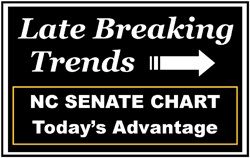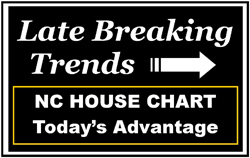Click the Play Button Below for an Audio Summary [audio:https://www.johndavisconsulting.com/wp-content/uploads/2010/08/JDavisRpt81610.mp3|titles=JDavisRpt81610] Key Trends and their Impact on North Carolina’s 2010 General Election Races Advantage Democrats Advantage Republicans High unemployment this fall, coupled with high underemployment and high anxiety among the employed, is a potentially lethal concoction of political variables for North Carolina Democrats. Post: August 16,
[More…]
| Click the Play Button Below for an Audio Summary |
| [audio:https://www.johndavisconsulting.com/wp-content/uploads/2010/08/JDavisRpt81610.mp3|titles=JDavisRpt81610] |
 |
 |
|
Key Trends and their Impact on North Carolina’s 2010 General Election Races
|
|
High unemployment this fall, coupled with high underemployment and high anxiety among the employed, is a potentially lethal concoction of political variables for North Carolina Democrats.
Post: August 16, 2010, by John Davis
If you will take a close look at the Senate and House Late Breaking Trends charts, you will see that I use “underemployment” rather than “unemployment.” Here is why:
Underemployment, at 18.5% today according to Gallup, is a far more politically significant predictor of voter behavior than unemployment. Underemployment includes both Americans who are unemployed and those who are working part-time but wanting full-time work. Especially hard hit are Americans without college degrees, where 23% are underemployed. Those voters are afraid, angry, and are not likely to vote for the ins come November.
Underemployment also helps in understanding why many voters among President Obama’s 2008 winning coalition have soured on politics in general … and Obama in particular. Young voters, those aged 18-to-29, have an underemployment rate of 28.4% … including 11.8% who are unemployed and 16.6% who are employed part-time but looking for full-time work. It’s no wonder that they have become disillusioned with political engagement.
Compounding the negative political fallout for Democrats of high underemployment is the lack of job security among those who are employed. According to a new study released today by Gallup, almost 40% of those who are employed are worried that their benefits will be reduced (39%), that they will be laid off or their wages cut (26%), or that their company will move their job overseas (8%).[i]
Add high underemployment to high anxiety among the employed and you can readily see why Democrats have a growing political problem.
Mortimer Zuckerman, chairman and editor in chief of US News and World Report, wrote an Op Ed piece in today’s WSJ[ii] in which he makes the following disconcerting observations:
- We are at least 2.5 million jobs short of getting back to the unemployment rate of 8% promised by the Obama administration
- We are coming out of the current recession at a 2.4% growth rate, as compared to the normal post-World War II recovery rate of 6% real GDP
- Real unemployment today is well above the headline number of 9.5% if you factor in the 1,115,000 people who gave up hope of finding work in the last three months
Zuckerman’s conclusions echo those of Federal Reserve Chairman Ben Bernankes, who told Congress last month that the country’s economic outlook remains “unusually uncertain.”[iii]
In politics, “unusual uncertainty” yields unusual turnover.
How long will it take to restore jobs for the underemployed and job security for the employed? “In all likelihood,” Bernanke told the US Senate Banking Committee in July, “a significant amount of time will be required to restore the nearly 8.5 million jobs that were lost over 2008 and 2009.”
The few short months remaining between now and Election Day November 2010 does not a significant amount of time make. High real unemployment this fall, coupled with high underemployment and high anxiety among the employed, is a potentially lethal concoction of political variables for North Carolina Democrats.
Now you know why I use underemployment rather than just unemployment. The politics of 2010 is being driven by numbers packing a much more powerful political punch than a mere 10% unemployment rate.
Tomorrow, I will being add a daily tracking chart to the bottom of the Senate and House Late Breaking Trends daily reports so that you can see how the partisan political advantage changes over time.
Meanwhile, take a look at the Late Breaking Trends charts above or in the sidebar. You will see that Republicans continue to have a partisan political advantage in both the state House and state Senate campaigns … despite the financial advantage of the Democratic Party. That’s because of underemployment.
[i] http://www.gallup.com/poll/142154/Workers-Elevated-Alert-Potential-Job-Pay-Cuts.aspx
[ii] http://online.wsj.com/article/SB10001424052748703960004575427332237529948.html
[iii] http://money.cnn.com/2010/07/21/news/economy/bernanke_testimony/index.htm